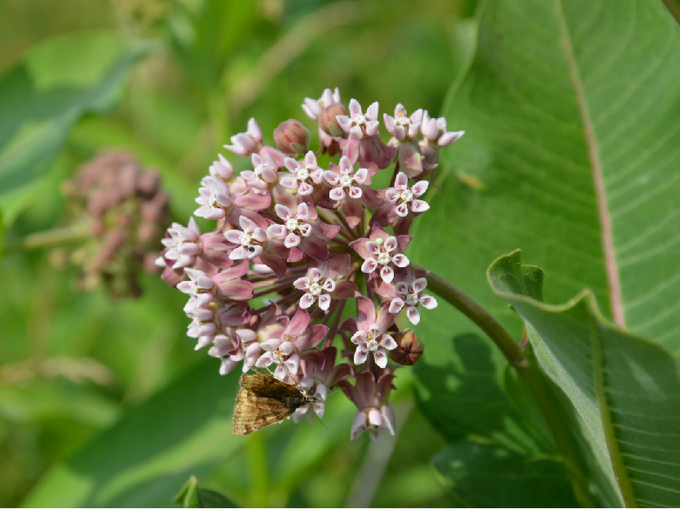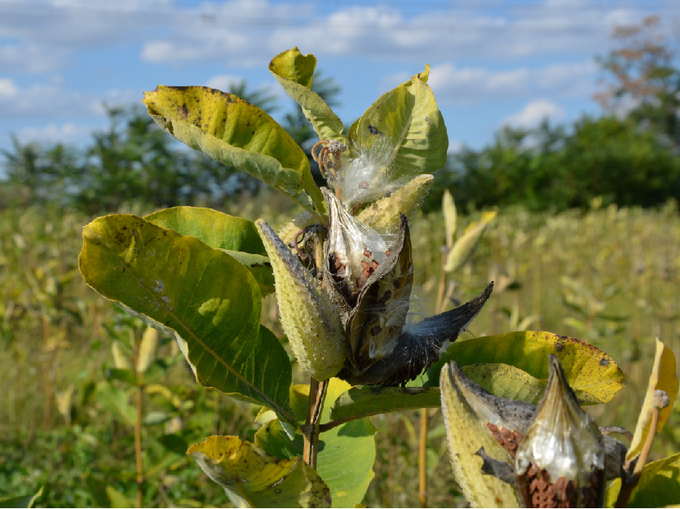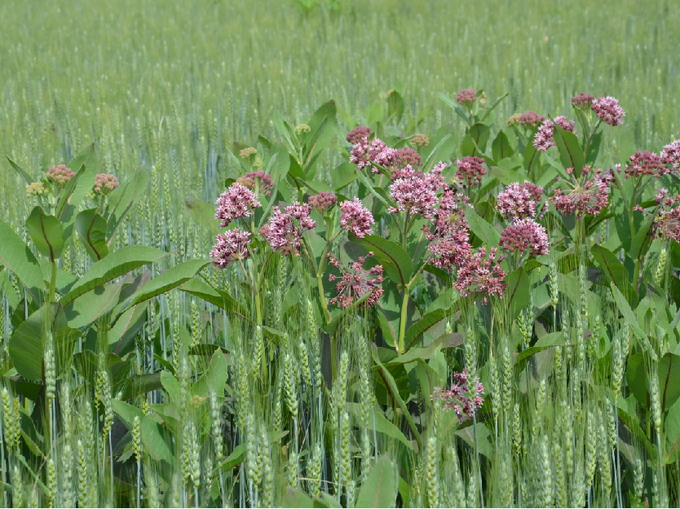Common milkweed
Asclepias syriaca
Appearance
The plant is perennial, lactiferous and grows up to 150 cm tall. The leaves are derb-leaved, opposite, with white felt-like hairs on the underside and up to 15-20 cm long. The brown-red and long-stalked flowers appear in many-flowered umbels. Flowering begins in early/mid-June under local conditions, and the plant produces soft-thorned, horn-shaped fruits about 10-15 cm long (hence the name "parrot fruit"). The brown seeds are 6-10 mm long and have a characteristic silky mop of hair. The common milkweed is poisonous.


Distribution
The original range of the common milkweed includes large parts of Canada and the USA. In Austria, the occurrences of the common milkweed have increased significantly since 2005 and a further spread is likely. Currently, the species occurs especially in eastern Austria (Vienna, Lower Austria) and only sparsely in western and southern Austria.
Spread
The plant was cultivated as an ornamental plant and bee pasture, in the vicinity of gardens repeatedly ran wild. The common milkweed prefers to colonize sunny and dry soils. Therefore, the species grows mainly on wastelands such as industrial wastelands, railroads, roadsides and pathsides, but also in agricultural areas. Spread of the common milkweed also occurs naturally via its silky-haired seeds, which are dispersed by wind in the fall. A reproductive shoot may produce two to three fruits, each containing 200 or more seeds. However, the species spreads under local conditions mainly vegetatively by means of its rhizomes. Sections of the rhizomes can be carried away with soil material (e.g. during road construction).
Economic importance
Common milkweed occurs as a weed in agriculture. Its growth rates are an important factor in its high competitive power and yield losses are possible. It mainly affects crops such as corn, soybean and cereals, but also vegetable crops. Due to its rapid spread and robustness, the species invades semi-natural areas (open forests, grasslands), but also habitats worthy of protection (including dry grassland sites) and can form very dense stands.


Prevention and control
Individuals and populations can be removed manually using appropriate equipment. However, the entire rootstock must be removed. Regular mowing can push back the common milkweed. Basically, the species can quickly regenerate from mechanical injuries. In agriculture, common milkweed is encouraged by reduced tillage and the simultaneous use of herbicides with an insufficient effect. The plant is considered relatively insensitive to a wide range of herbicides and the effect is highly dependent on timing of treatment. Growth herbicides usually cause only superficial damage to the plant. Established populations of common milkweed can best be controlled with glyphosate, according to the literature. See also the list of plant protection products approved in Austria.
Specialized information
Follak, S., Bakacsy, L., Essl, F., Hochfellner, L., Lapin, K., Schwarz, M., Tokarska-Guzik, B., Wołkowycki, D., 2021. monograph of invasive plants in Europe N°6: Asclepias syriaca L., Botany Letters. DOI: 10.1080/23818107.2021.1886984
Follak, S., 2018. the common milkweed - (not) a problem weed. The Plant Doctor 71(11-12), 18-19.
Follak, S., Schleicher, C., Schwarz, M., 2018. roads support the spread of invasive Asclepias syriaca in Austria. Die Bodenkultur: Journal for Land Management, Food and Environment 69, 257-265.
Last updated: 10.09.2024
automatically translated